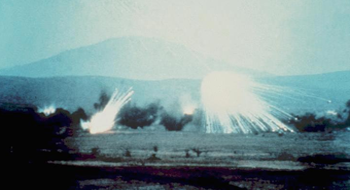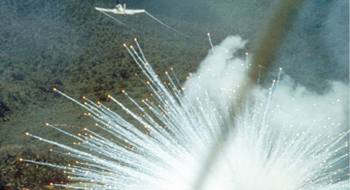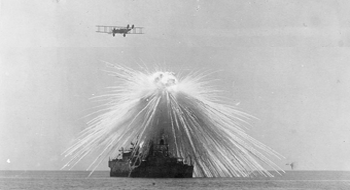


Elemental phosphorus was first extracted from urine in 1669 by the German alchemist Hennig Brandt. Of the several different types of elemental phosphorus, Brandt produced white phosphorus (WP), which starts to burn upon exposure to air at 30°C (86°F) in moist conditions and at 35-46°C (95-115°F) in dry conditions. WP also glows in the dark and emits smoke. WP can be stored in water to prevent reactions with oxygen.
In 2004, according to the United States Geological Survey, the United States mined 163,000,000 metric tons of phosphate rock, mostly for fertilizer. Only a tiny fraction ends up as elemental phosphorous, used in chemical manufacturing, firecrackers, some rat and rodent poisons, and various military munitions.
According to the Chemical Weapons Convention Schedule of Chemicals, the chemical P4 is neither a toxic chemical nor a precursor to a toxic chemical. Protocol III of The Convention on Prohibition or Restrictions on the Use of Certain Conventional Weapons Which May be Deemed to be Excessively Injurious or to Have Indiscriminate Effects (CCW) prohibits and restricts the use of incendiary weapons in civilian populations. It defines an incendiary weapon as "any weapon or munition which is primarily designed to set fire to objects or to cause burn injury to persons"; this definition excludes "munitions which may have incidental effects, such as illuminants, tracers, smoke or signaling systems." Under that qualification, WP is not necessarily considered an "incendiary weapon" if it incidentally sets buildings on fire. The United States has ratified other protocols and amendments of the CCW, but it has not ratified Protocol III.
Initially, contaminated clothing should be removed to prevent re-ignition. Treating skin exposed to WP requires irrigation of the contaminated areas or placement of water- or saline-soaked pads. If the area becomes dry, then the WP can re-ignite. In addition, bathing the area in a bicarbonate solution will neutralize any phosphoric acid that may have been produced. Remaining WP particles should be immediately removed surgically. Removal requires care to prevent further contamination of the person or responders. After complete removal, the patient can be treated as a burn victim.
American Chemical Society, CDC, eMedicine, NATO, UN Department of Disarmament Affairs, U.S. Army, USGS